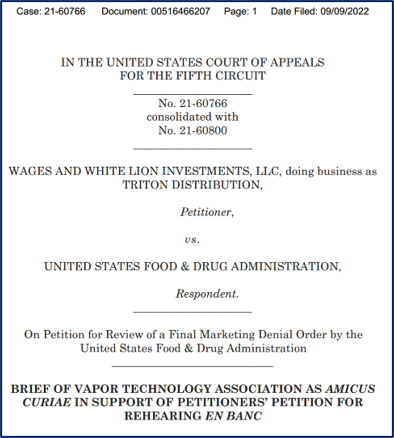Welcome to the December edition of the VTA Insider, your industry focused briefing from the Vapor Technology Association.
VTA Insider keeps you informed of critical issues impacting the nicotine products industry both in Washington, DC and in the states. We will cover regulatory developments, legislation, news of note and other industry insights. VTA will also share our analysis of what we as an industry need to do to grow and prosper.
Let’s Dive In.
Reagan-Udall Issues Critical Report on FDA Tobacco

The big picture: Last July, FDA Commissioner Robert Califf called for an indpendent review of the FDA’s heavily criticized Center for Tobacco Products (CTP) by the Reagan-Udall Foundation (RUF). The RUF report, released last week, painted a troubled picture of a CTP’s culture, inconsistent and opaque rules and standards, and political interference with what should be scientific decisions.
What the experts found: RUF’s independent panel of tobacco experts found:
- CTP has no strategic plan and must create one that identifies the Center’s strategic objectives and plots an operational roadmap to achieve them.
- CTP has not clearly articulated what is required to meet the appropriateness for the protection of public health (APPH) standard or how it is applying the APPH standard.
- CTP struggles to function as a regulator due to some of its own policy choices.
- CTP faces significant challenges in clearing policies through the career and political infrastructure.
- CTP lacks consistent implementation of its own policies, particularly with respect to harm reduction.
RUF Recommendations: Some of the most important recommendations of the independent tobacco expert panel:
- “The Panel strongly recommends that the center invests the time – now – in … thinking strategically about where it is deficient, where it needs to be in the future, and how best to get to that future.”
- “The path to resolving many of the Center’s current challengesstarts with establishing the scientific and policy framework to make clear and timely product decisions.”
- “The plan must … explain how FDA is interpreting the APPH standard.”
- “CTP has a responsibility to clearly identify application requirements.”
- “CTP must resolve how to weigh the public health benefits of adults who use ENDS that will quit smoking combustible tobacco products against the potential public health harms to youth who use e-cigarettes.”
Why it matters: Using the addled prcess described by RUF, CTP hasrejected the overwhelming majority of applications for millions of less-harmful vaping products and has done so without being able to articulate how it is balancing the public health standard.
Keeping score: 600 – 8 – 0 – 0 – 0 – 0
- 600 = the # of combustible tobacco products, including 250 new cigarettes, authorized for sale.
- 8 = the # of less harmful tobacco-flavored e-cigarettes authorized.
- 0 = the # of less harmful menthol-flavored e-cigarettes authorized.
- 0 = the # of less harmful other-flavored e-cigarettes authorized.
- 0 = the # of less harmful open-system devices authorized.
- 0 = the # of less harmful nicotine pouch products authorized.
Our thought bubble: “The FDA Commissioner should instruct CTP to stand down on issuing any further denials of less harmful nicotine alternative product applications until CTP has been able to review and implement the safeguards and recommendations made by the Reagan-Udall Foundation, and VTA stands ready to assist FDA and CTP by providing the necessary stakeholder input that the Foundation also said was necessary,” said VTA’s Executive Director.
Read VTA’s full statement on the RUF Report, VTA’s oral testimony to RUF, the summary of VTA’s recommendations and its full written submission to RUF.
Watch VTA’s Executive Director discuss the RUF report on Regulator Watch.
Where’s the logic?

The big picture: On October 26, 2022, FDA denied Logic Technology Development, LLC’s (LOGIC) menthol-ENDS PMTA applications claiming that LOGIC failed to prove that its menthol products were appropriate for the protection of public health (APPH). But, in documents made public recently, LOGIC revealed that CTP’s Office of Science changed its standards for reviewing menthol-ENDS PMTAs aftereffectively being told to do so by the CTP Center Director’s office.
- In a memo written by the head of the Office of Science, it was disclsoed that the scientists initially decided to authorizeLOGIC’s menthol-ENDS products back “in the latter half of 2021” after taking into account all factors including potential attraction to youth.
- But, after the Center Director’s office “shared [its] views,” the Office of Science changed its approach and recommendation to deny LOGIC’s menthol PMTAs.
Why it matters: It appears that CTP is applying the same flawed youth-oriented decision making process for evaluating menthol-flavored vaping products as it did other-flavored vaping products. In other words, anypotential youth use outweighs LOGIC’s studies demonstrating little to no youth uptake and significant adult smoking cessation.
What we’re saying: CTP’s decision was made during using a process which the Reagan-Udall Foundation was highly critical of due to CTP’s lack of transparency on the balancing test and what appear to be scientific decisions getting overriden by policymakers at the agency. VTAshared copies of the internal FDA memos with the Reagan-Udall Foundation before it issued its report.
What’s next: LOGIC, having already filed suit, has its case on what appears to be a fast track so we hope to see a court decision soon.
Worth your time…

Must-see webinar on age-gating. Missed the recent webinar Protecting your Brand, Products, & Consumers: Age-Gating and Supply Chain Security? Watch this free 60-minute webinar moderated by Dr. Jessica Zdinak, with Dave DeJean and Eric Hawk. Use the passcode: =rk0V3k0
Attorney General Tom Miller and leading tobacco-control scientists published a must-read editorial in Addiction entitled United States Public Health Officials Need to Correct E-cigarette Health Misinformation
“Health misinformation is harmful as it can cause confusion and sow mistrust regarding the adoption of public health recommendations and policies. We provide examples of e-cigarette misinformation promoted by the United States public health officials, which have persisted despite new data challenging the validity of the original assertions.”
VTA Executive Director Tony Abboud speaks to Regulator Watchabout a number of regulatory updates. Abboud discusses litigation, flavored ENDS appeals, and Supreme Court flavor cases and much more.
Happy Holidays To All

We at VTA are wishing everyone a safe (warm!) and happy holidays as we look forward to a new year filled with change and prosperity!
Stay tuned in with us for lots of new developments in the coming year and make sure your friends and colleagues are signed up to receive our news and information..





